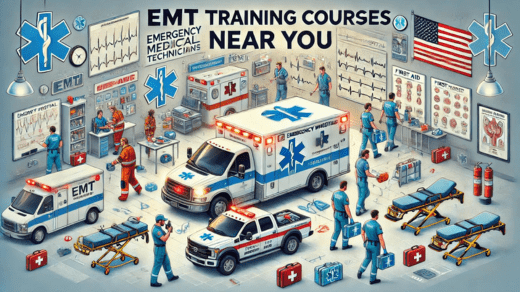Discover the best EMT training courses and certification options in our comprehensive guide. Get started on your path to becoming an EMT today!
Are you interested in EMT training courses, EMT training classes, or looking for EMT training courses near you? Emergency Medical Technicians (EMTs) are essential in providing pre-hospital care and saving lives in emergency situations. To become a certified EMT, individuals must undergo rigorous training and pass certification exams. In this comprehensive guide, we will explore everything you need to know about EMT training courses, certification programs, and the career opportunities that await you in this rewarding field.
Understanding the Importance of EMT Training Courses
EMT training courses are designed to equip individuals with the necessary knowledge and skills to respond to medical emergencies effectively. These courses cover a wide range of topics, including patient assessment, trauma care, medical emergencies, and ambulance operations. By enrolling in EMT training classes, aspiring EMTs learn how to stabilize patients, administer basic life support, and transport individuals to medical facilities safely.
Choosing the Right EMT Certification Program
When selecting an EMT certification program, it is essential to consider factors such as accreditation, curriculum, and hands-on training opportunities. Accredited programs adhere to industry standards and ensure that graduates are well-prepared to enter the workforce. Additionally, look for programs that offer clinical rotations or internships to gain practical experience in real-world settings.
Accreditation and Program Reputation
EMT training courses near me vary in quality, so it’s crucial to choose a program that is accredited by the Commission on Accreditation of Allied Health Education Programs (CAAHEP) or the Committee on Accreditation of Educational Programs for the Emergency Medical Services Professions (CoAEMSP). These accreditations guarantee that the program meets established standards of excellence.
Curriculum and Hands-On Training
A robust EMT certification program should cover essential topics such as anatomy, physiology, pharmacology, and emergency procedures. Hands-on training, including simulation exercises and clinical rotations, allows students to apply their knowledge in realistic scenarios and develop critical thinking skills.
A Step-by-Step Guide to Becoming an EMT
Becoming an EMT involves several key steps, starting with completing an accredited EMT training course and passing the National Registry of Emergency Medical Technicians (NREMT) exam. After obtaining certification, EMTs must maintain their credentials through continuing education and periodic recertification.
EMT Training Levels
There are three levels of EMT training: EMT-Basic, EMT-Intermediate, and EMT-Paramedic. Each level builds upon the skills learned in the previous one, with EMT-Paramedics having the most advanced training and scope of practice.
NREMT Certification
The NREMT exam is a standardized test that assesses the knowledge and skills of aspiring EMTs. Passing this exam is a requirement for obtaining state licensure and working as an EMT in most jurisdictions.Training Course Type Description Advantages Traditional Classroom-Based In-person instruction with hands-on practice led by experienced educators. Face-to-face interaction, structured learning environment. Hybrid Programs Blend of online coursework with on-site skills labs and clinical rotations. Flexibility of online learning with practical experience in a supervised setting. Online EMT Courses Fully online courses offering flexibility and convenience for remote learning. Access from anywhere, self-paced learning.
Exploring Different Types of EMT Training Courses
EMT training courses come in various formats, including traditional classroom-based instruction, hybrid programs that combine online learning with hands-on training, and fully online courses. Each format offers unique advantages and flexibility to accommodate different learning styles and schedules.
Traditional Classroom-Based Courses
Traditional EMT training classes provide in-person instruction led by experienced educators and hands-on practice with medical equipment. This format is ideal for students who prefer face-to-face interaction and structured learning environments.
Hybrid Programs
Hybrid EMT courses blend online coursework with on-site skills labs and clinical rotations. This format allows students to complete a portion of their training remotely while still gaining practical experience in a supervised setting.
Online EMT Courses
Online EMT training courses offer flexibility and convenience for students who may have busy schedules or live in remote areas. While online courses require self-discipline and motivation, they provide access to high-quality instruction from anywhere with an internet connection.
Top Online Resources for EMT Certification Preparation
Preparing for EMT certification exams requires dedication and thorough review of key concepts and skills. Fortunately, there are many online resources available to help aspiring EMTs study and practice for their exams effectively.
NREMT Practice Exams
Taking practice exams that simulate the format and content of the NREMT exam is an excellent way to assess your knowledge and identify areas that require further study. Many websites offer free and paid practice exams to help you prepare for the real test.
Online Study Guides and Flashcards
Online study guides and flashcards are valuable tools for reviewing essential EMT concepts and terminology. These resources break down complex topics into digestible chunks and facilitate memorization of key information.
Virtual Simulation Tools
Virtual simulation tools allow students to practice scenarios in a controlled virtual environment, improving their decision-making skills and confidence in emergency situations. These tools offer a hands-on learning experience that complements traditional classroom instruction.
Practical Tips for Excelling in EMT Training Programs
To succeed in EMT training courses, students should prioritize organization, time management, and self-care. Balancing academic studies, practical skills training, and personal well-being is essential for thriving in a demanding and fast-paced educational environment.
Create a Study Schedule
Developing a study schedule that allocates time for reviewing course materials, practicing skills, and taking breaks is key to staying on track and retaining information effectively. Consistent study habits contribute to long-term retention of knowledge.
Seek Feedback and Collaboration
Engaging with instructors, peers, and mentors for feedback and collaboration enhances learning and promotes a supportive academic community. Constructive criticism and mentorship from experienced professionals can help students refine their skills and build confidence.
Prioritize Self-Care
EMT training can be physically and emotionally demanding, so it’s crucial to prioritize self-care and well-being. Getting enough rest, eating nutritious meals, and engaging in stress-relieving activities are essential for maintaining overall health and performance.
Navigating the Requirements for EMT Certification
Obtaining EMT certification involves meeting specific requirements set by state regulatory agencies or certifying bodies. These requirements typically include completing an approved training program, passing a certification exam, and meeting continuing education obligations for recertification.
State-Specific Licensure
Each state has its own requirements for EMT certification and licensure, so it’s essential to research the regulations in your state to ensure compliance. Some states may have additional requirements beyond national certification for EMT practice.
Continuing Education
EMTs are required to participate in continuing education courses to stay up-to-date on the latest medical advancements and maintain their skills. Continuing education ensures that EMTs provide high-quality care and adhere to best practices in the field.
Career Opportunities After Completing EMT Training Courses
Upon completing EMT training courses and obtaining certification, graduates have various career opportunities in the field of emergency medical services. EMTs can work in diverse settings, including ambulance services, fire departments, hospitals, and urgent care facilities, providing essential care to individuals in need.
Ambulance Services
Many EMTs work for ambulance services, responding to emergency calls, assessing patients, and providing on-site medical treatment. Ambulance services are a critical component of the healthcare system, ensuring that individuals receive prompt and effective care during emergencies.
Fire Departments
Some EMTs are employed by fire departments, where they respond to medical emergencies, fires, and other hazardous situations. EMTs in fire departments collaborate closely with firefighters to ensure the safety and well-being of the community.
Hospitals and Urgent Care Centers
EMTs may also work in hospitals and urgent care centers, where they assist healthcare providers in triaging patients, administering treatments, and transporting individuals between facilities. Working in a hospital setting exposes EMTs to a wide range of medical conditions and procedures.
Real-Life Stories from EMT Professionals
To provide a glimpse into the real-world experiences of EMT professionals, we have gathered inspiring stories from individuals working in the field. These stories highlight the challenges, rewards, and impact of being an EMT, showcasing the dedication and compassion required to excel in this demanding yet fulfilling career.
Story 1: Saving Lives on the Frontlines
John, a seasoned EMT with ten years of experience, recounts a harrowing experience of responding to a multi-car collision on the highway. Despite the chaos and urgency of the situation, John and his team worked tirelessly to stabilize multiple injured individuals and transport them to the hospital, ultimately saving several lives that day.
Story 2: Building Relationships with Patients
Emily, a compassionate EMT who works in a rural community, shares her journey of building meaningful relationships with her patients over time. From providing medical care to offering emotional support, Emily emphasizes the importance of empathy and connection in her role as an EMT, demonstrating the human side of emergency medical services.
Story 3: Pursuing Specialized Training
Michael, an ambitious EMT seeking to advance his career, discusses his decision to pursue specialized training in critical care transport. By undergoing additional education and certification, Michael aims to enhance his skills and expand his scope of practice, illustrating the opportunities for growth and development in the field of emergency medical services.
In conclusion, EMT training courses offer a pathway to a rewarding and impactful career in emergency medical services. By choosing the right certification program, mastering essential skills, and staying committed to ongoing learning and development, aspiring EMTs can make a difference in the lives of individuals in need. Whether responding to emergencies on the frontlines or providing compassionate care in a healthcare setting, EMTs play a vital role in the healthcare system and community at large.

